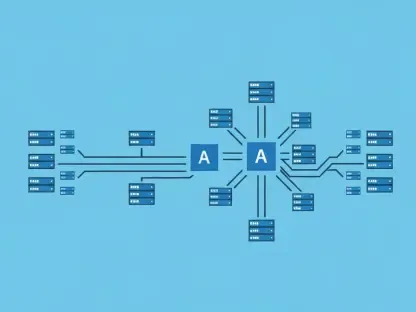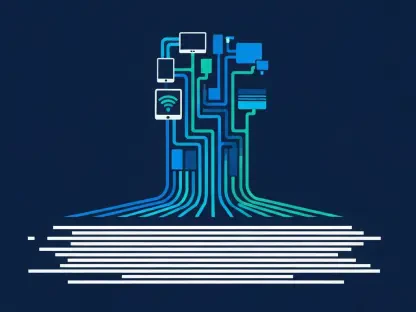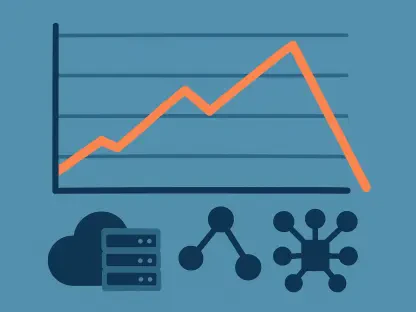In an era where cyber threats are escalating at an unprecedented rate, organizations must prioritize robust cybersecurity measures. The average organization faces 1,636 cyberattacks per week, which marks a significant 30% increase from the previous year. This alarming trend underscores the critical need for advanced cybersecurity risk assessment tools. These tools are essential for identifying, evaluating, and mitigating potential vulnerabilities within IT infrastructures, ensuring organizations remain resilient against evolving threats.
The Rising Tide of Cyber Threats
Increasing Frequency and Severity of Cyberattacks
Organizations around the globe are experiencing a surge in cyberattacks, with both the frequency and severity of these incidents on the rise. This unsettling trend is illustrated by a range of statistics and real-world examples that underscore the growing cyber threat landscape. Companies are not only facing more attacks, but the magnitude of these threats also brings more severe consequences. Financial losses due to cyber incidents can be staggering, often leading to millions of dollars in damage. In addition to monetary setbacks, businesses face reputational damage, as public trust may wane following significant breaches.
Operational disruptions further highlight the devastating impact of cyberattacks. When critical systems go offline, productivity can plummet, and recovery efforts become time-consuming and costly. This reality emphasizes the necessity for businesses to fortify their defenses against cyber threats. The increasing reliance on digital infrastructure means that no organization is immune, and without adequate protection, the risk of severe operational and financial repercussions looms large.
The Need for Proactive Cybersecurity Measures
Given the increasing number and complexity of cyber threats, it is imperative for organizations to adopt proactive cybersecurity measures. Reactive approaches can often leave vulnerabilities exposed for too long, allowing potential breaches to cause significant damage before they are addressed. Proactive strategies, including continuous monitoring and regular risk assessments, play a crucial role in anticipating and mitigating risks before they materialize into full-blown incidents.
Security teams must implement advanced tools that provide a comprehensive understanding of their organization’s threat landscape. These tools offer invaluable insights, allowing for the early detection of vulnerabilities and enabling timely responses to potential threats. In a landscape where cyber adversaries are perpetually evolving their tactics, proactive measures ensure that organizations can stay ahead, effectively reducing their risk profile and fortifying their defenses. This proactive stance is vital for maintaining the integrity and operational continuity of today’s digitally-dependent businesses.
The Role of Automation in Cybersecurity
Workflow Automation in Enhancing Security Operations
Automation plays a crucial role in modern cybersecurity strategies, offering significant enhancements in security operations. By automating repetitive and time-consuming tasks, organizations can reduce human error and free up their security teams to focus on more critical threats. For instance, automated tools can handle routine activities such as threat detection, data analysis, and incident response, allowing security personnel to prioritize more complex issues that require human intervention. This strategic allocation of resources not only increases efficiency but also ensures a faster and more accurate response to potential threats.
The benefits of workflow automation extend to improved threat detection capabilities. Automated systems can continuously scan for anomalies and potential vulnerabilities across networks, endpoints, and cloud environments. This constant vigilance minimizes the window of opportunity for cyber adversaries to exploit weaknesses. With increased efficiency and faster response times, organizations are better equipped to mitigate risks and protect their digital assets. Additionally, automation solutions often come with sophisticated analytics that provide deeper insights into the threat landscape, enabling a more informed and strategic approach to cybersecurity management.
The Impact of Automation on Digital Transformation
Automation is not only vital for enhancing security operations but also plays a pivotal role in facilitating digital transformation initiatives. Organizations undergoing digital transformation must adapt to new technological landscapes, integrating advanced solutions that streamline processes and improve operational efficiency. Automation supports these goals by optimizing workflows, reducing manual intervention, and ensuring that cybersecurity measures keep pace with evolving digital environments.
As businesses adopt new technologies and expand their digital footprints, the complexity of managing security increases. Automation tools help to manage this complexity by providing a unified and consistent approach to risk assessment and threat management. They ensure that security protocols are uniformly applied across all digital assets, from on-premises infrastructure to cloud-based applications. Furthermore, automation aids in compliance management by maintaining continuous oversight and generating reports that demonstrate adherence to regulatory standards. Ultimately, the integration of automation in cybersecurity operations not only bolsters security but also propels organizations toward successful digital transformation.
Understanding Cybersecurity Risk Assessment
Defining Cybersecurity Risk Assessment
Cybersecurity risk assessment is a fundamental process that involves evaluating risks and identifying vulnerabilities related to an organization’s digital assets. This comprehensive evaluation helps organizations understand the nature and extent of potential threats, as well as the likelihood of their exploitation. The process typically involves several key steps, beginning with the identification of critical assets and the mapping of their respective threat landscapes. Each asset is then analyzed to assess its vulnerability to different types of cyberattacks.
The methodologies used in cybersecurity risk assessment can vary, but they generally include both quantitative and qualitative approaches. Quantitative methods involve numerical measures and statistical models to estimate the probability and impact of potential risks, whereas qualitative methods rely on expert judgment and scenario analysis to evaluate the severity of threats. The objective is to develop a clear and actionable risk profile that informs the organization’s security strategies. Understanding this profile is crucial for prioritizing security efforts, allocating resources effectively, and enhancing the overall resilience of digital infrastructures.
The Importance of Risk Assessment Tools
Modern businesses increasingly rely on cybersecurity risk assessment tools to enhance threat visibility, streamline risk management, and ensure regulatory compliance. These tools offer a range of benefits, including the ability to conduct continuous risk assessments and maintain up-to-date visibility into the organization’s threat landscape. By automating the risk assessment process, businesses can reduce the time and effort required to identify and address vulnerabilities. This automation is especially valuable in environments with rapidly changing threat dynamics, where manual processes may struggle to keep pace.
Risk assessment tools also play a crucial role in reducing the potential impact of data breaches. Early detection and management of vulnerabilities help prevent breaches from escalating into significant incidents with widespread consequences. These tools can provide detailed analytics and reporting capabilities, allowing organizations to track trends over time and measure the effectiveness of their security measures. Additionally, they support regulatory compliance by generating documentation and reports that demonstrate adherence to legal and industry standards. This capability ensures that businesses do not only protect their assets but also comply with relevant regulations, mitigating legal and financial risks.
Key Features and Benefits of Top Cybersecurity Risk Assessment Tools
SentinelOne Singularity™
SentinelOne Singularity™ stands out as an AI-driven platform designed to provide extended detection, rapid threat neutralization, and comprehensive endpoint, cloud, identity, and network protection. One of its primary benefits is its ability to continuously scan for threats, offering real-time analytics that enhance an organization’s ability to detect and respond to potential breaches. The platform employs machine learning algorithms to identify and mitigate risks, ensuring that threat detection is both thorough and efficient.
Moreover, SentinelOne Singularity™ offers automated incident response capabilities that significantly reduce the response time to detected threats. This immediate action can be crucial in preventing the spread of an attack and minimizing its impact. Additionally, the platform provides comprehensive endpoint protection, safeguarding devices against malware, ransomware, and other malicious activities. The integrated visibility across endpoints, cloud environments, and networks allows security teams to maintain a holistic view of their security posture and respond to threats with greater effectiveness.
ProcessUnity
ProcessUnity focuses on third-party risk management, providing organizations with the tools needed to assess and manage risks associated with vendors and partners. By automating workflows, ProcessUnity simplifies the process of evaluating vendor compliance and tracking potential risks. The platform’s robust reporting and analytics capabilities enable organizations to gain insights into their third-party risk landscape and make informed decisions to enhance security.
The tools offered by ProcessUnity help organizations ensure that their vendors adhere to security standards, reducing the likelihood of third-party data breaches. Automated compliance tracking simplifies the task of monitoring vendor activities and identifying any deviations from established security protocols. This proactive management of third-party risks is essential for maintaining the integrity of the organization’s digital ecosystem and safeguarding sensitive data shared with external partners. The platform’s advanced analytics provide a clear view of the third-party risk landscape, empowering organizations to implement effective mitigation strategies and maintain a strong security posture.
Cybereason
Cybereason is widely recognized for its endpoint detection and response capabilities, leveraging behavioral analytics to identify and mitigate threats. The platform’s advanced algorithms analyze endpoint activities to detect unusual patterns that may indicate a potential cyberattack. By automating incident responses, Cybereason ensures that threats are addressed promptly, minimizing the impact on the organization.
Endpoint visibility and integration of threat intelligence are pivotal components of Cybereason’s offering. The platform provides a comprehensive view of endpoint security, ensuring that every device connected to the network is monitored and protected. Real-time threat intelligence integration enhances the platform’s ability to identify new and emerging threats, providing security teams with the information needed to respond effectively. Cybereason’s holistic approach to endpoint security, combining advanced analytics, automated response, and continuous monitoring, makes it a powerful tool for organizations seeking to fortify their defenses against evolving cyber threats.
Choosing the Best Cybersecurity Risk Assessment Tool
Scalability and Integration Capabilities
When selecting a cybersecurity risk assessment tool, scalability and integration capabilities are essential factors to consider. A tool that can scale with the organization’s growth ensures that as the number of assets and potential vulnerabilities increases, the security solution remains effective. Scalability is particularly important for organizations experiencing rapid expansion or those operating in dynamic environments where the threat landscape can change quickly.
Integration capabilities are equally crucial, as the chosen tool must seamlessly integrate with existing security systems to provide a cohesive and comprehensive security ecosystem. This integration allows for unified threat detection and response, leveraging data and insights from multiple sources to enhance overall security. An integrated solution can streamline operations, reduce complexity, and improve the efficiency of security workflows. Organizations should prioritize tools that offer robust integration features, ensuring compatibility with current infrastructure and the ability to adapt to future technological advancements.
Usability, Automation, and Customizability
Usability, automation, and customizability are key considerations when choosing a cybersecurity risk assessment tool. A user-friendly interface ensures that security personnel can quickly and effectively navigate the tool, optimizing productivity and minimizing the learning curve. High usability is particularly important in fast-paced security environments, where quick and efficient action is necessary to counter threats.
Automation features are indispensable for reducing human error and accelerating the risk assessment process. Tools that automate repetitive tasks and provide real-time alerts allow security teams to focus on more strategic decisions and responses. For instance, automated threat detection and incident response can vastly improve response times and reduce the potential impact of security incidents. Furthermore, customizability enables organizations to tailor the tool to meet specific needs and requirements. This flexibility ensures that the security solution aligns with the organization’s unique risk profile and operational objectives, enhancing its overall effectiveness in managing cybersecurity risks.
Comprehensive Coverage and Compliance Support
A robust cybersecurity risk assessment tool should offer comprehensive coverage across networks, endpoints, applications, and cloud infrastructures. This holistic approach ensures that all potential entry points for cyber threats are monitored and protected. Comprehensive coverage is critical for maintaining complete visibility into the threat landscape, allowing security teams to detect and address vulnerabilities across the entire digital environment.
In addition to broad coverage, compliance support is a vital component of an effective risk assessment tool. Organizations must adhere to various regulatory standards, such as GDPR, HIPAA, and PCI-DSS, which mandate stringent data handling and security practices. A tool that simplifies compliance management by providing templates, automated reporting, and real-time monitoring ensures that organizations remain audit-ready and compliant with relevant regulations. This capability not only mitigates legal and financial risks but also builds trust with customers and stakeholders, reinforcing the organization’s commitment to data security and privacy.
Vendor Support and Documentation
Vendor support and comprehensive documentation are essential for the successful deployment and use of a cybersecurity risk assessment tool. Robust vendor support ensures that organizations receive the necessary assistance and guidance during the implementation and configuration phases. This support is crucial for addressing any technical challenges and optimizing the tool’s performance to meet specific security needs.
Comprehensive documentation provided by the vendor serves as a valuable resource for security teams, offering detailed instructions on configuration, troubleshooting, and best practices. Access to thorough documentation facilitates a smoother onboarding process and empowers security personnel to utilize the tool effectively. Ongoing vendor support, combined with detailed documentation, ensures that organizations can maintain the tool’s functionality and adapt to evolving security requirements over time. This partnership between the vendor and the organization is key to achieving sustained security and resilience against cyber threats.
Threat Intelligence Integration and User Education Support
Integrating threat intelligence into a cybersecurity risk assessment tool provides up-to-date insights on emerging threats, offering a strategic advantage in combating new risks. Threat intelligence integration enhances the tool’s ability to detect and respond to threats more effectively, leveraging real-time data on known and potential attack vectors. By incorporating insights from global threat databases, organizations can stay ahead of cyber adversaries and adapt their security measures to address evolving risks.
User education support is also a critical feature of an effective risk assessment tool. Employees play a crucial role in an organization’s cybersecurity posture, and their awareness and vigilance significantly impact overall security. A tool that offers user education programs, training modules, and simulation exercises helps to build a culture of security within the organization. Educated users are more likely to recognize and report suspicious activities, reducing the likelihood of successful phishing attacks and other social engineering tactics. By fostering a security-aware workforce, organizations can enhance their defenses and mitigate the human element of cybersecurity risks.
Conclusion
In today’s world, where cyber threats are increasing at an unprecedented pace, organizations must give top priority to robust cybersecurity measures. On average, organizations face approximately 1,636 cyberattacks each week, reflecting a staggering 30% increase from the previous year. This worrisome trend highlights the urgent need for advanced cybersecurity risk assessment tools.
These tools are indispensable for identifying, evaluating, and mitigating potential vulnerabilities within IT infrastructures. By leveraging these tools, organizations can enhance their resilience against an ever-evolving landscape of cyber threats. Cybersecurity risk assessment tools help security teams understand where their systems might be vulnerable, allowing them to take proactive steps to protect their data and assets.
In addition to deploying these advanced tools, it’s crucial for organizations to keep abreast of the latest cybersecurity trends and continuously update their security protocols. Investing in employee training and educating staff about best practices for cybersecurity can also significantly contribute to an organization’s overall defense strategy. By doing so, organizations can better safeguard themselves against the sophisticated techniques employed by cybercriminals and ensure the security and integrity of their operations.









